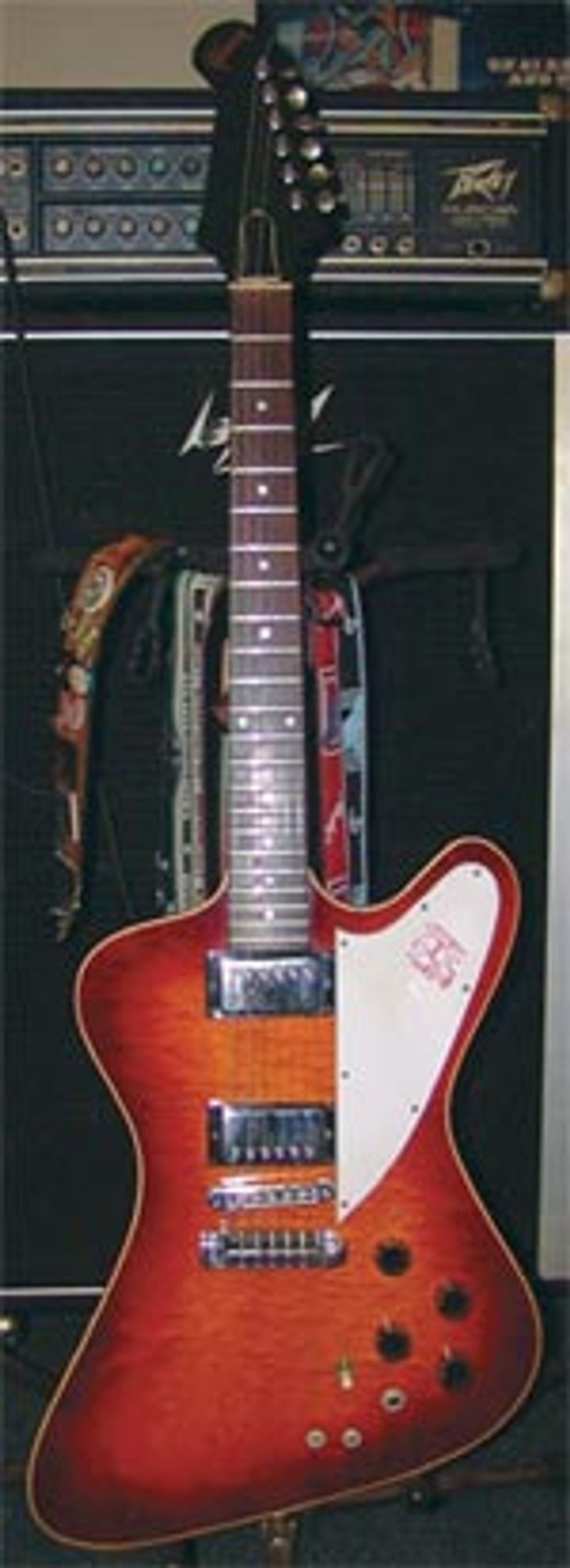This month, Zach discovers a 1981 Gibson Firebird with a few peculiarities.

I have a 1981 Gibson Firebird II that has active electronics with two micro switches, and two tone controls that go 5-0-5 instead of going from 1-10 like the volume knobs. I know the tone knobs cut or boost something, but I am not sure exactly what. I also have no idea what the two switches do. Can you give me some background on the guitar, what the value is, and what the two micro switches do?
Craig Parlee
Hey Craig,
Before we get into your guitar, let’s take a look at Gibson’s past president, Ted McCarty, and the origins of the original Firebird. After McCarty’s modernistic designs in the late 1950s (Explorer, Flying V, Moderne) were initially regarded as failures and discontinued, he tried one more radical solidbody design before he resigned from Gibson in 1966. Instead of designing this new guitar with help from within the company, McCarty hired longtime automotive designer, Ray Dietrich, who was retired and living in Kalamazoo, Michigan.
Introduced in mid-1963, the original “reverse” Firebird featured several designs that had never been used on other guitars up to that point. The body was vaguely similar to the Explorer, with extended lower treble and upper bass bouts, but the corners were more rounded and not as extreme. Gibson also used a long, one-piece neck that ran the entire length of the body. Instead of Gibson’s normal square headstock, a backwards, Strat-style headstock was used. The tuners on a headstock like this would normally face the treble side of the guitar, making it awkward for the player to tune the guitar. However, banjo-style tuners that pointed straight down were used to make tuning more accommodating. A new humbucker pickup, which was smaller than Gibson’s normal humbucker and lacked pole pieces, was used on these guitars; it soon became known as the “mini-humbucker” and would be used on several other Gibson guitars in the future.
The automotive connection between Gibson and Dietrich went beyond just the design as they named the guitar the Firebird and the matching bass guitar the Thunderbird (Ford already had a Thunderbird model in production and Pontiac would introduce the Firebird in 1967). The Firebird was also available in four different trim levels, similar to its Les Paul and SG counterparts. However, instead of using Junior, Special, Standard and Custom designations, Gibson used odd Roman numerals: I, III, V and VII (the Thunderbird basses used even Roman numerals II and IV).
Unfortunately for Gibson, Fender had received a patent for the similar Jazzmaster in 1959. Although the patent contained no specific elements of Fender’s guitar, the drawing did show an asymmetrical-style body with offset body waists. Fender contacted Gibson concerning infringement of their design patent, but rather than go to court, McCarty redesigned the entire Firebird line in 1965. The new Firebird (often referred to as the “non-reverse” models) featured an even less extreme body with slightly longer upper bass and lower treble bouts, a standard set neck and P-90 pickups on various models. The non-reverse Firebirds lacked the flair of the reverse models and the guitar was discontinued in 1969.
Your guitar, the Firebird II, seems to be a mutt of sorts, with aspects taken from various other Gibson guitars of the same era, specifically the Explorer II and Flying V CMT. The Firebird had already appeared with reissues during the 1970s, and by then they had reverted back to the reverse body style that had been so popular. The flame maple top was used on the Flying V CMT and the TP-6 fine tune tailpiece was used on the Explorer II.
Your guitar features the original reverse offset double cutaway maple body, a figured bound maple top, three-piece maple neck, 22-fret rosewood fingerboard with dot inlays, reverse headstock with black overlay and pearl Gibson logo, six-on-theother- side tuners, Tune-o-matic bridge, TP-6 fine tune tailpiece, white pickguard with red Firebird logo, two Series IV humbucker pickups, active electronics, four black barrel knobs (two Volume, two Tone), 3-way pickup switch, two mini switches (one to switch between standard and active electronics and one for brightness), chrome hardware, and an Antique Fireburst finish. The 5-0-5 tone knobs utilize cut and boost for treble and bass like most normal active electronics, as opposed to 0-10 Tone knobs found on passive electronics. Today, this guitar is worth between $1800 and $2250 in excellent to mint condition – definitely a treasure!
Zachary R. Fjestad
Zachary R. Fjestad is the author of the Blue Book of Acoustic Guitars, Blue Book of Electric Guitars, and the Blue Book of Guitar Amplifiers.
Questions can be submitted to:
Blue Book Publications
Attn: Guitar Trash or Treasure
8009 34th Ave. S. Ste #175
Minneapolis, MN 55425
800-877-4867
www.bluebookinc.com
guitars@bluebookinc.com
Please include pictures of your guitars.

